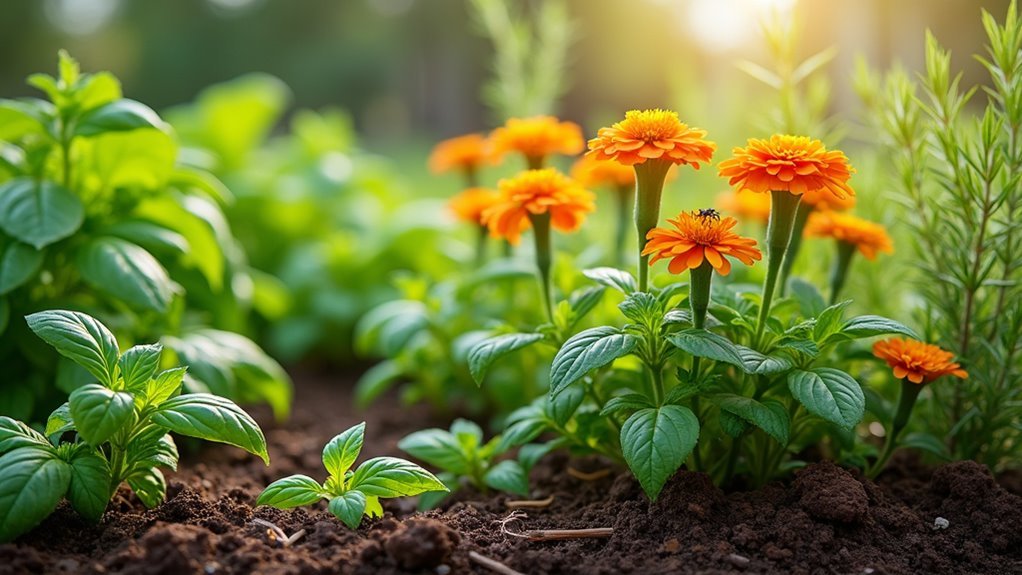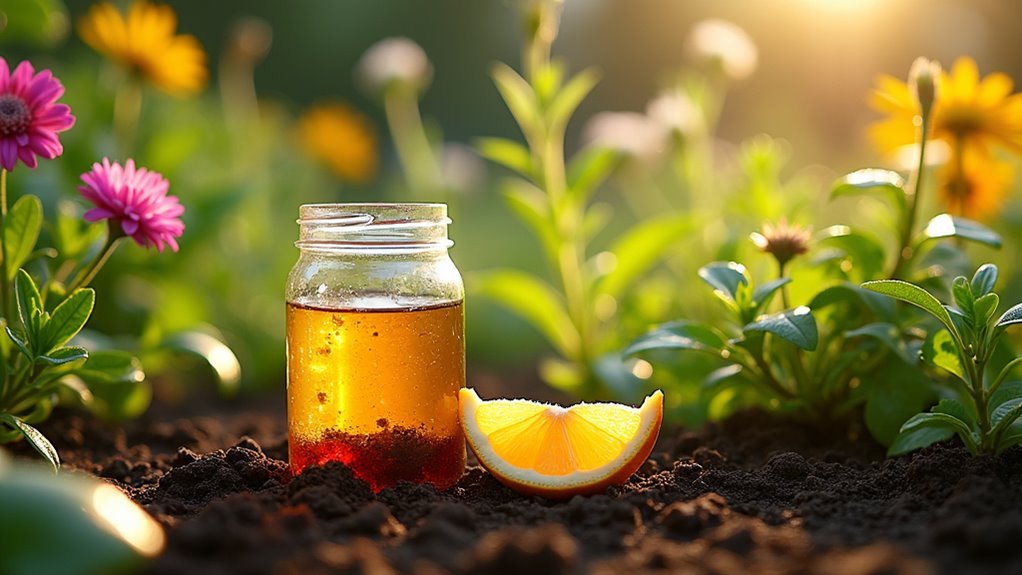You can tackle yard pests naturally with seven effective DIY solutions. Set beer traps for slugs and snails, create yellow sticky traps for flying insects, and sprinkle diatomaceous earth barriers around your garden perimeter. Make homemade garlic and essential oil sprays, apply beneficial nematodes for grub control, and implement companion planting strategies with marigolds and basil. Use simple water and soap pan traps for small insects. These chemical-free methods will transform your pest management approach completely.
Beer Traps for Slugs and Snails

When slugs and snails invade your garden, beer traps offer an effective and eco-friendly solution that turns these pests’ attraction to fermented beverages against them.
You’ll need a shallow container like a yogurt cup, which you should bury so the rim sits level with the ground for easy pest access.
Fill the container with beer, leaving about an inch below the rim to create an ideal drowning effect while preventing spillage. The scent attracts slugs and snails, who’ll fall in and drown.
This non-toxic method provides one of the most effective solutions to protect garden plants without harmful chemicals.
Check and refill your beer traps regularly, especially after rain or watering, to maintain their effectiveness throughout the growing season.
Yellow Sticky Traps for Flying Insects
While beer traps handle ground-dwelling pests, flying insects require a different approach that capitalizes on their visual attraction to specific colors. Yellow sticky traps are effective for pest control because many flying insects naturally gravitate toward this bright hue.
Creating these traps involves simple steps:
- Cut yellow cardstock or plastic into various shapes for maximum visual appeal.
- Apply a sticky substance like petroleum jelly or Tanglefoot to both sides.
- Position traps on stakes or hang them strategically near affected plants.
- Perform regular maintenance by checking and replacing traps as needed.
These traps don’t just capture pests—they also help you monitor pest activity patterns.
When integrated into your overall garden strategy, yellow sticky traps become valuable tools in integrated pest management, providing ongoing protection while giving you insights into which flying insects are targeting your plants.
Diatomaceous Earth Barriers Against Crawling Pests

For crawling pests that evade aerial traps, diatomaceous earth offers a ground-level defense that’s both natural and highly effective. This non-toxic solution contains fossilized diatom remains that damage insect exoskeletons, causing fatal dehydration in ants, cockroaches, and fleas.
You’ll create an impenetrable barrier by sprinkling food-grade diatomaceous earth around your yard’s perimeter. These natural pest controllers work immediately upon contact, making them excellent effective DIY pest management tools.
Apply DE during dry conditions for maximum potency, as moisture reduces effectiveness. Regular applications help control existing pest populations while working to prevent infestations before they establish.
Reapply after heavy rain or watering to maintain protection. Unlike chemical alternatives, food-grade DE remains safe around pets and family members throughout treatment.
Homemade Garlic and Essential Oil Sprays
You can create powerful pest deterrents using common kitchen ingredients like garlic cloves and essential oils.
These natural sprays offer significant advantages over chemical alternatives, including safety for beneficial insects and pleasant aromas that won’t overwhelm your outdoor space.
Proper mixing techniques and storage methods will guarantee your homemade solutions remain effective throughout the growing season.
Garlic Spray Recipe
Creating an effective garlic spray requires just two main ingredients and can protect your garden from multiple pest species simultaneously.
This natural deterrent represents one of the most reliable DIY solutions for organic gardening enthusiasts seeking chemical-free pest control methods.
Garlic Spray Preparation Steps:
- Blend and steep – Combine 1-2 whole garlic bulbs with one quart of water, then let steep for 24 hours to extract sulfur compounds.
- Strain and enhance – Filter the mixture and add one tablespoon of liquid dish soap for better adhesion.
- Optional boosters – Mix in essential oils like peppermint or neem for enhanced effectiveness.
- Strategic application – Spray generously on both the tops and undersides of leaves, reapplying every 7-14 days.
This water in a spray solution effectively deters garden pests including aphids, caterpillars, and spider mites.
Essential Oil Benefits
Adding specific oils to your garlic spray creates a powerful combination that targets different pest species more effectively than garlic alone.
Essential oils like peppermint, lavender, and eucalyptus provide natural pest control that’s both safe and non-toxic for your garden environment. Peppermint oil excels at deterring spiders and ants when mixed with your garlic sprays and applied around entry points.
You’ll enhance effectiveness by combining these oils with soap or vinegar, which helps the mixture adhere better to plant surfaces.
Always test your spray on a small area first to prevent plant damage. This approach lets you repel pests without harmful chemicals, making it effective for gardens where children and pets spend time.
Application and Storage
Three key factors determine your homemade spray’s success: proper application timing, correct storage methods, and thorough testing before widespread use.
These natural solutions require strategic implementation to effectively repel pests:
- Apply during ideal conditions – Spray your garlic spray and essential oil sprays during early morning or late afternoon when direct sunlight won’t reduce their potency.
- Test before widespread application – Always test homemade sprays on a small plant area first to check for adverse reactions before broader use.
- Store properly – Keep your spray bottle contents in cool, dark places using tightly sealed containers to maintain efficacy and extend shelf life.
- Monitor effectiveness – Regular reapplication ensures continuous pest deterrence, especially after rain or heavy watering that dilutes the natural compounds.
Beneficial Nematodes for Grub Control
While chemical pesticides can harm beneficial insects and contaminate your soil, beneficial nematodes offer a natural solution that specifically targets grubs without affecting the helpful creatures in your garden.
These microscopic roundworms hunt down garden pests by entering their bodies and releasing deadly bacteria. They’re completely safe for use in residential gardens, posing no threat to pets, children, or beneficial insects.
Apply nematodes to moist soil during evening hours or cloudy days to prevent them from drying out. Use an application rate of 1-5 million nematodes per 1,000 square feet, depending on your infestation level.
This eco-friendly pest control method provides long-lasting control since nematodes reproduce in the soil, creating an ongoing defense system against grubs.
Companion Planting for Natural Pest Deterrence

You can harness nature’s own pest control system by strategically pairing plants that naturally repel unwanted insects through their scents and chemical properties.
When you plant basil near tomatoes or marigolds alongside vegetables, you’ll confuse pests like aphids and nematodes while creating a protective barrier around vulnerable crops.
Success depends on thoughtful garden layout planning that considers which companion plants work best together and how to position them for maximum pest-deterrent effect.
Strategic Plant Pairings
When you strategically pair certain plants together, you’re creating a natural pest management system that’s been used by gardeners for centuries.
Companion planting works by leveraging plants’ natural properties to enhance growth and reduce pests without chemicals. These strategic plant pairings create a balanced ecosystem that protects your garden while supporting beneficial insects.
Here are four proven combinations for effective pest control:
- Basil with tomatoes – The herb’s strong scent confuses pests targeting your tomato plants.
- Marigolds throughout vegetable gardens – These flowers repel nematodes and harmful insects while attracting pollinators.
- Garlic among roses – The pungent odor masks rose scents that attract aphids.
- Carrots with onions – Onion scent confuses carrot flies seeking their target.
You’ll attract beneficial predators like ladybugs by including flowering plants such as dill and yarrow.
Scent-Based Pest Confusion
Because pests rely heavily on scent to locate their target plants, you can exploit this dependency by creating aromatic barriers that disrupt their navigation systems.
Scent-based pest confusion through companion planting offers an effective natural deterrent that’ll repel pests without chemicals. Plant basil near tomatoes—its strong aroma masks tomato scents, deterring aphids and whiteflies.
Marigolds excel at repelling nematodes with their distinct fragrance, while garlic’s powerful scent can confuse pests targeting nearby vegetables.
When you establish diverse species together, you’re creating a balanced ecosystem that makes it considerably harder for pests to locate their preferred hosts.
This strategic approach will reduce pest population throughout your garden while promoting healthy plants that thrive in this naturally protective environment.
Garden Layout Planning
Strategic garden layout planning transforms your outdoor space into a natural fortress against pests through deliberate companion plant positioning.
This natural pest control solutions approach creates a diverse planting layout that keeps pest populations under control while encouraging beneficial insects.
Here’s how interplanting creates your balanced ecosystem:
- Plant marigolds around vegetables – their strong scents naturally repel nematodes and harmful insects while attracting pollinators.
- Position garlic near roses – this companion planting strategy uses aromatic barriers for repelling pests like aphids effectively.
- Use nasturtiums as a trap crop – they’ll draw destructive insects away from your valuable plants.
- Mix flowering and edible plants – this diversity encourages ladybugs and lacewings to establish permanent residence in your garden.
Water and Soap Pan Traps for Small Insects
Why spend money on expensive pesticides when you can capture troublesome small insects with a simple water and soap pan trap? This DIY solution effectively targets flea beetles and other tiny pests using basic household items.
Skip costly pesticides and catch flea beetles with a simple water and dish soap trap made from household items.
Fill a shallow dish with water and add several drops of dish soap to break surface tension, preventing insects from escaping once they land. Position your pan traps at ground level or slightly elevated where they’ll attract insects seeking moisture and food sources.
The eco-friendly method provides consistent insect capture without toxic chemicals that harm beneficial garden creatures. Refresh the soap mixture regularly to maintain effectiveness.
You’ll discover this simple approach controls small insect populations naturally while protecting your family and environment from harmful chemical pesticides.
Frequently Asked Questions
What Is the Best Homemade Pest Killer?
You’ll find that mixing equal parts water and white vinegar creates the most versatile homemade pest killer, effectively repelling ants and disrupting their scent trails when you spray it around entry points.
Can You Use Vinegar and Dawn as Insecticide?
You can definitely use vinegar and Dawn as an effective insecticide. Mix equal parts of both ingredients, then spray directly on insects or their nests to repel and eliminate various pests safely.
Is DIY Pest Control as Good as Professional?
DIY pest control can match professional services for minor infestations and maintenance, but you’ll likely need professionals for severe problems like termites or rodents requiring specialized tools and expertise.
How to Keep Pests Out of Your Yard?
You’ll prevent pests by regularly cleaning debris, planting repelling herbs like basil and marigolds, installing physical barriers, using eco-friendly mulches, and creating habitats for beneficial insects that naturally control pest populations.
In Summary
You’ve got seven powerful DIY tools to tackle yard pests without harsh chemicals. Start with the solutions that match your specific pest problems, and don’t hesitate to combine methods for better results. Remember, consistency is key—check your traps regularly and reapply sprays as needed. These natural approaches will protect your plants while keeping your garden safe for family and beneficial insects. Your pest-free yard is within reach.





Leave a Reply